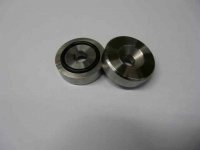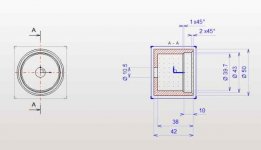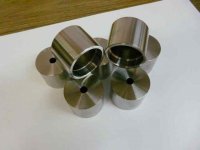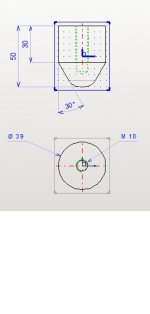The design looks very proffesional Doitmyself.Hi Rcruz, I use 3205 bearing (bottom), which accept high weight. See drawing for contact points.
Sincerely
I did use a small ball bearing in my first pickup project (not very professional). This did not work ball-bearings rumble them selves. (I do not know if there are better categories of qaulity in ball-bearing)
You are reinventing the wheel there all bearings for TT are one ball (iron or ceramic) and a guide-bearing because it is the most quit. Like in the old Thorens TD124.
Here a clearaudio-bearing floating on a magnetic field and guide bearing so they also loose the last ball as bearing because they cause the noise.
An externally hosted image should be here but it was not working when we last tested it.
I think a weak-plastic housing for the bronze bush so the plastic absorbs noise of the guide bearing a hard metal axes and a ceramic ball as bearing. And a O-ring as a damper in the axes how carries the weight of the platter.
Last edited:
reinventing the wheel
Amusingly, rotate the drawing by 90 degrees and it even resembles a car wheel bearing/hub assembly.
A real automobile enthousiast would add a torque converter inbetween the motor drive axle and the belt.
For yachts, lowest vibration inducing propulsion type is a fluid drive (plus doesn't require a clutch)
Ah, one fine day i'll make a Mariner turntable, with a main axis bushing of guaiacum, outlasts any bronze bushing and only wood type that sinks.

Last edited:
Only problem your wheels will be blown away by the magnets.Amusingly, rotate the drawing by 90 degrees and it even resembles a car wheel bearing/hub assembly.
A real automobile enthousiast would add a torque converter inbetween the motor drive axle and the belt.
.
Amusingly, rotate the drawing by 90 degrees and it even resembles a car wheel bearing/hub assembly.
A real automobile enthousiast would add a torque converter inbetween the motor drive axle and the belt.
For yachts, lowest vibration inducing propulsion type is a fluid drive (plus doesn't require a clutch)
Ah, one fine day i'll make a Mariner turntable, with a main axis bushing of guaiacum, outlasts any bronze bushing and only wood type that sinks.
LOL
I'm curious, I really want to see how it will works with my bearings, I'll do mesurements of noise comparing with a Technics TT. If really not good, not a problem I have other solutions.
The most important is that I have fun realising my own self made TT. But I also take care about your comments, and will take attention while assembling the TT.
And of course, can transform it for a care cooler too.
The most important is that I have fun realising my own self made TT. But I also take care about your comments, and will take attention while assembling the TT.
And of course, can transform it for a care cooler too.
OK, I have finished the fixing pieces. And I also had the prices of the servodrive and servo motor that OMRON had offered me: 1179 euros for the drive and 669 euros for the motor (taxes not included). THANKS Mr DESTRAS Patrice from OMRON.
Attachments
really want to see how it will work
At least, you will have constructed the bulkiest TT bearing/axle ever.
I can't think of any example that comes even close, dimension wise.
YEP.At least, you will have constructed the bulkiest TT bearing/axle ever.
I can't think of any example that comes even close, dimension wise.
There are 7 pieces !!!!!!!!Next step: foot closers and silent bloc closers
THANK you Bonsai,Wow, I've just read through this thread - fantastic.
I wish I had your mechanical engineering skills. I can only echo the other posters here - I cannot wait to see the finished product!
Very cool!
I'm just trying to realise a dream.
The single motor pulley and belt pulls the platter to one side, side-loading the platter bearing a bit. This can be good (eliminating play) or bad (adding friction and noise). If you had two or three motors (or bearing spindles w/ pulleys) evenly spaced around the platter there would be no side force on the bearing. The belt might absorb any additional noise.
Good luck getting a linear tonearm bearing to work; it hasn't been previously achieved in a practical design that tracks well w/ light needle pressure. Usually the shaft rotates and wheels on the arm make the arm tail trail and self-align like the rear wheels on a trailer (Rabco, noisy). Or there's a powered lead-screw with an optical (laser and mirrors) system with detectors to drive the lead-screw forward or back (noisy). Or linear air bearings (long and heavy, exotic alloys). Or various hanging parallelograms...(oscillates). Or floating the end of the arm in a long liquid pool with opposed magnets to keep the floating boat centered in the short dimension of the long pool. The mass must be very very low, the friction nearly non-existent. You might experimentally lighten the linear bearing afterward, milling and drilling... You may find that two linear bearing surfaces spaces apart have less friction. I thought I could do OK with two small air bearings spaced apart but never got it reliable and stable enough flying high. Still in the end I think you're going to have a problem. Maybe you could add forced oil pressure to make the linear bearing non-contact, but it might not self-center without spinning the shaft. If you can get it to work the simplicity is nice, but it's not going to be easy. Make it easy to level the entire unit, as the arm will be sensitive to being out-of-level.
You have more guts than I; I was going to look into Acrylic Platter & Bearing Assembly for DIY LP Turntable | eBay or Timaudio DIY 70mm Platter + Bearings for your turntable | eBay http://i16.ebayimg.com/05/i/001/a0/64/dd14_10.JPG but in the end I decided to recondition an old direct-drive and add platter material, purchase an arm. Good luck and good learning for us all.
Good luck getting a linear tonearm bearing to work; it hasn't been previously achieved in a practical design that tracks well w/ light needle pressure. Usually the shaft rotates and wheels on the arm make the arm tail trail and self-align like the rear wheels on a trailer (Rabco, noisy). Or there's a powered lead-screw with an optical (laser and mirrors) system with detectors to drive the lead-screw forward or back (noisy). Or linear air bearings (long and heavy, exotic alloys). Or various hanging parallelograms...(oscillates). Or floating the end of the arm in a long liquid pool with opposed magnets to keep the floating boat centered in the short dimension of the long pool. The mass must be very very low, the friction nearly non-existent. You might experimentally lighten the linear bearing afterward, milling and drilling... You may find that two linear bearing surfaces spaces apart have less friction. I thought I could do OK with two small air bearings spaced apart but never got it reliable and stable enough flying high. Still in the end I think you're going to have a problem. Maybe you could add forced oil pressure to make the linear bearing non-contact, but it might not self-center without spinning the shaft. If you can get it to work the simplicity is nice, but it's not going to be easy. Make it easy to level the entire unit, as the arm will be sensitive to being out-of-level.
You have more guts than I; I was going to look into Acrylic Platter & Bearing Assembly for DIY LP Turntable | eBay or Timaudio DIY 70mm Platter + Bearings for your turntable | eBay http://i16.ebayimg.com/05/i/001/a0/64/dd14_10.JPG but in the end I decided to recondition an old direct-drive and add platter material, purchase an arm. Good luck and good learning for us all.
Last edited:
Hi Cyclecamper,
Yes you're right on every points, it will be very difficult.
About the tangential tonearm, yes same difficulties. And my second project is a classical tonearm with thuya burl.
About the motors, also yes it's a good idea to use several motors, but the one I will use, costs with his drive about 1850 euros (without taxes, 2220 euros taxes included), imagine 3 sets!!
The problem of pieces from ebay, that they costs a lot. I have the opportunity to be able to realise mine's.
And, THANKS for your support.
Yes you're right on every points, it will be very difficult.
About the tangential tonearm, yes same difficulties. And my second project is a classical tonearm with thuya burl.
About the motors, also yes it's a good idea to use several motors, but the one I will use, costs with his drive about 1850 euros (without taxes, 2220 euros taxes included), imagine 3 sets!!
The problem of pieces from ebay, that they costs a lot. I have the opportunity to be able to realise mine's.
And, THANKS for your support.
It's very boring to realise serial pieces.
Try machining 100 bronze cannons for a scale model 17th century war ship (7 Provinces, 100:1), including spares.
Never again.
NO, I will not try.Try machining 100 bronze cannons for a scale model 17th century war ship (7 Provinces, 100:1), including spares.
Never again.
- Status
- This old topic is closed. If you want to reopen this topic, contact a moderator using the "Report Post" button.
- Home
- Source & Line
- Analogue Source
- DIY Personal Turntable



